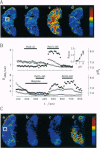Abstract
Transduction of the auxin stimulus in plants is thought to entail binding of the hormone to a soluble auxin-binding protein (ABP) outside the cell and subsequent interaction between this auxin-protein complex and an integral membrane receptor ("docking") protein that couples the signal across the plasma membrane. To explore the structural requirements for ABP function, synthetic peptides were prepared to the amino acid sequences of the predicted surface domains of ABPzm1, the dominant ABP from Zea. Biological function was assayed under voltage clamp, monitoring the ability of the peptides to evoke auxin-related modulations in inward- (IK,in) and outward-rectifying (IK,out) K+ channel activities of Vicia guard cells in the absence of added auxin. Only the peptide corresponding to the C-terminal domain of ABPzm1 was active. The dominant response was an inactivation of IK,in, although the peptide also evoked an activation of IK,out. Inactivation of IK,in was complete within 20-30 s and was fully reversible, was marked by a slowing of voltage-dependent activation and deactivation, and was dependent on peptide concentration (K1/2, 16 +/- 6 microM). Buffering cytoplasmic-free [Ca2+] with EGTA had no effect on IK,in response to the peptide. However, virtually complete and reversible block of the response was achieved when cytoplasmic pH (pHi) was brought under experimental control using the weak acid butyrate. Parallel measurements of pHi using the fluorescent dye 2',7'-bis(2-carboxyethyl-5(6)-carboxyfluorescein (BCECF) and dual-wavelength laser-scanning confocal microscopy demonstrated that the C-terminal peptide evoked rapid and reversible cytoplasmic alkalinizations of 0.4 +/- 0.1 pHi unit and confirmed the antagonism of the pHi response in the presence of butyrate. These, and comparable results with the auxins indole acetic acid and 1-naphthyleneacetic acid, implicate the C-terminal domain of ABPzm1 in auxin-ABP coupling to pHi and an associated intracellular signaling cascade.
Full text
PDF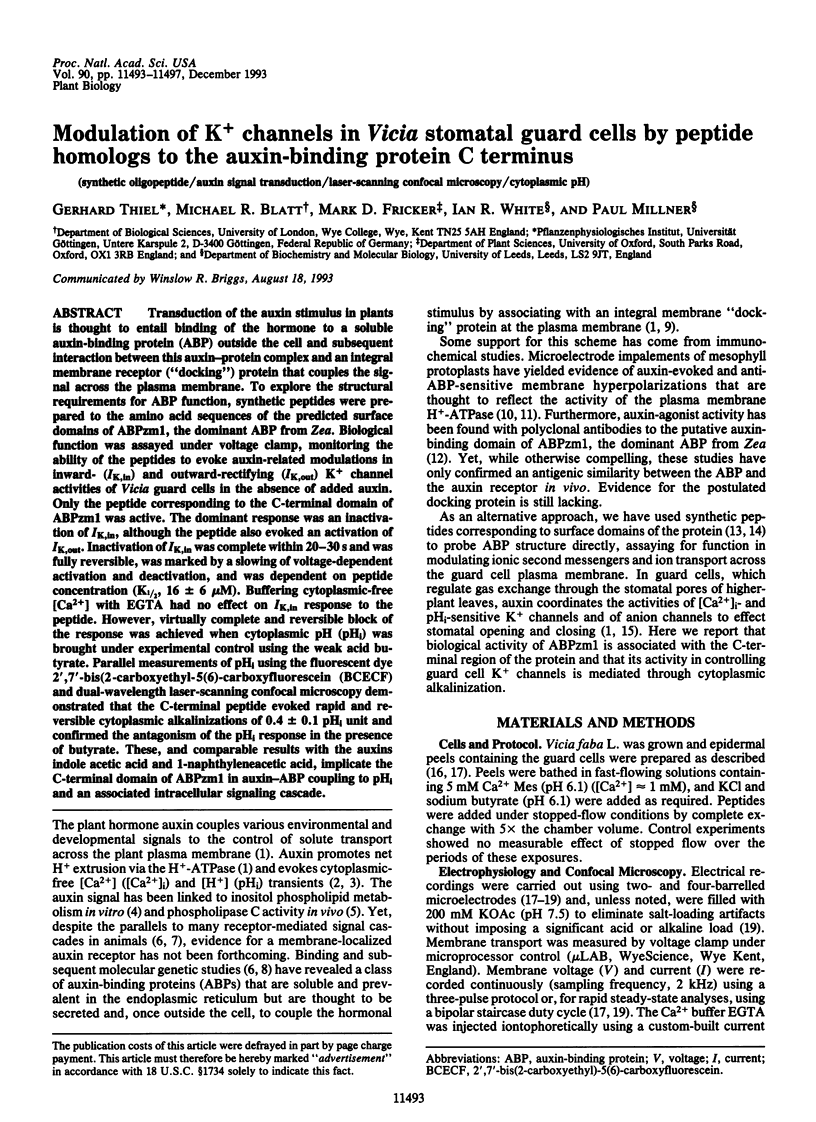
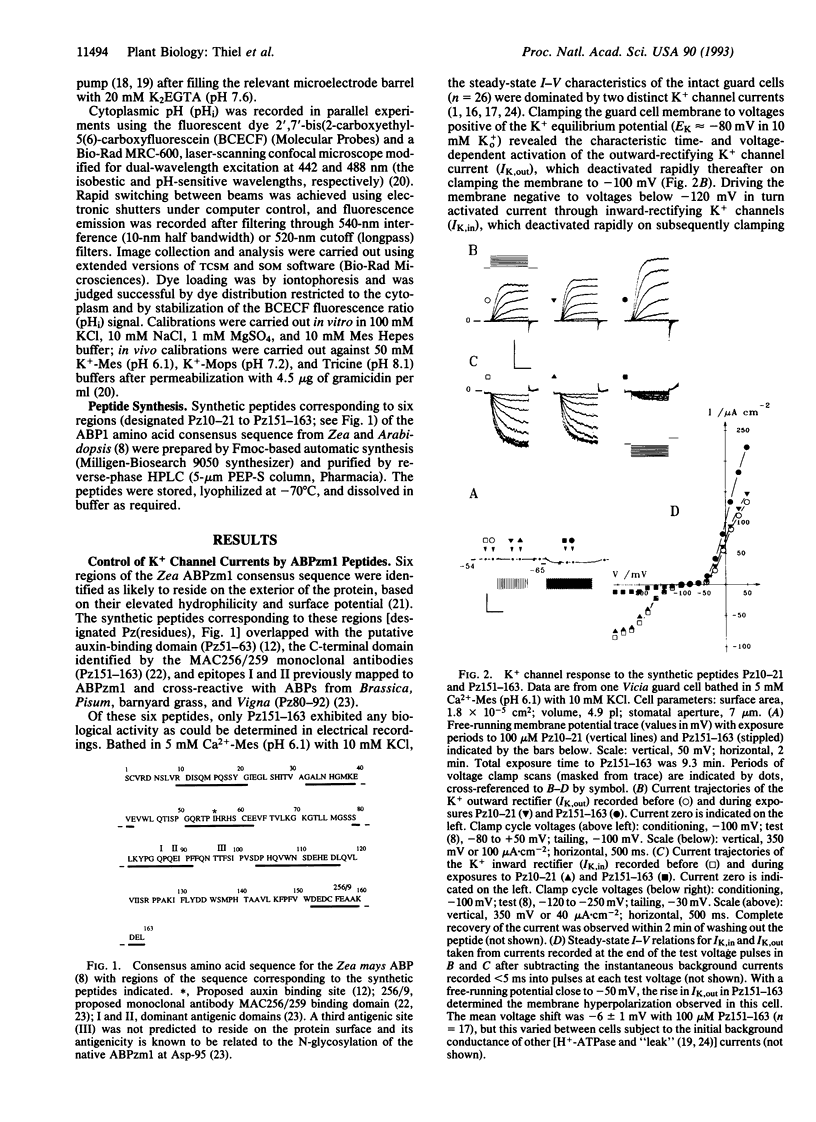
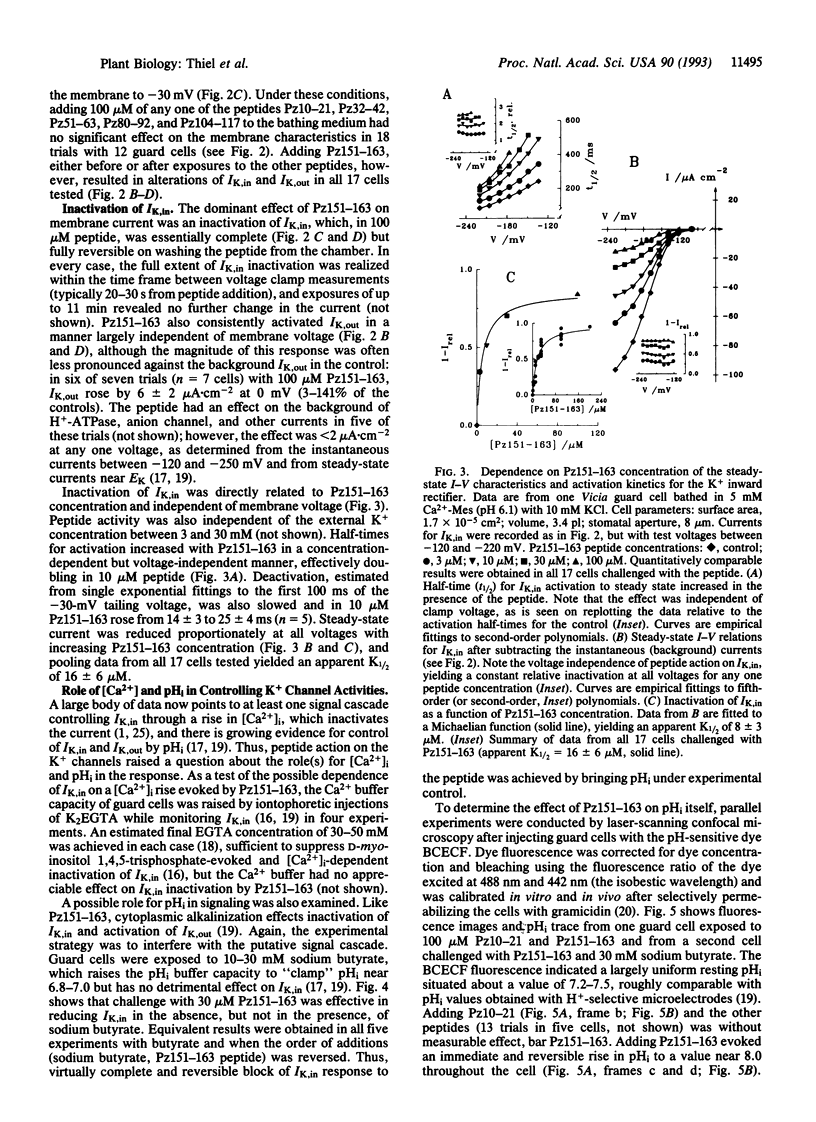
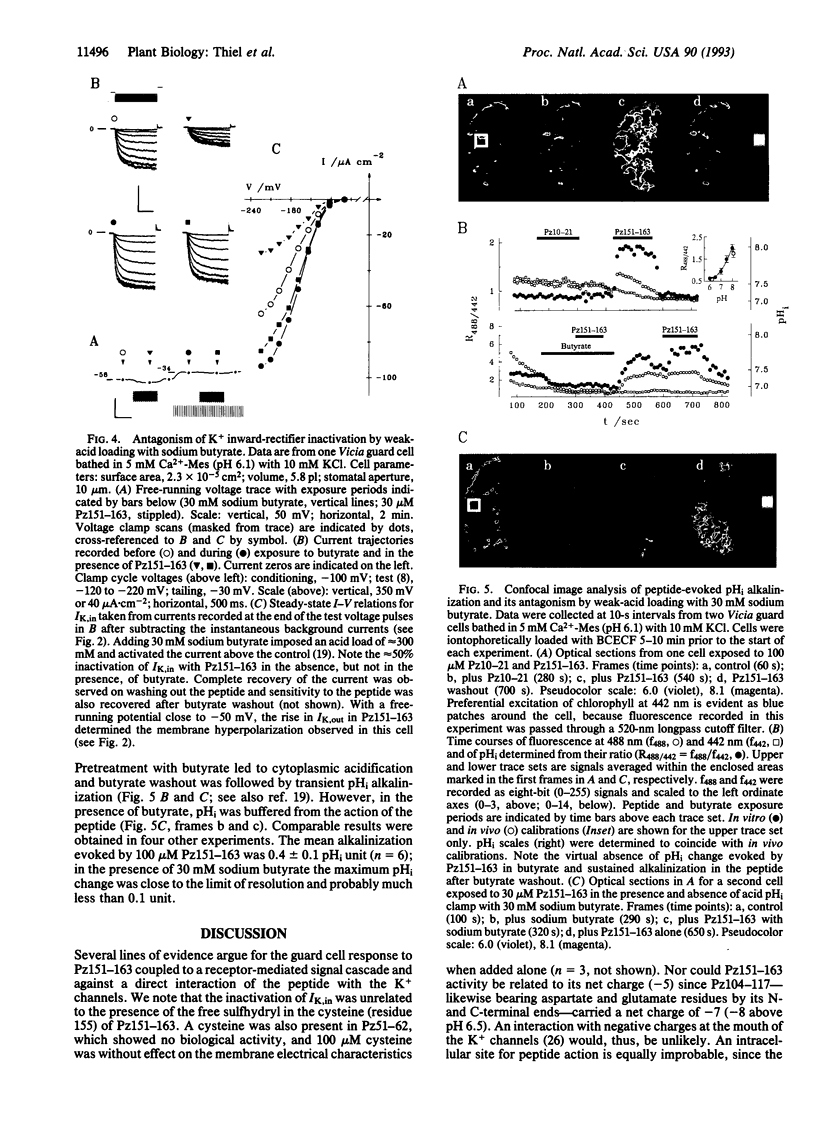
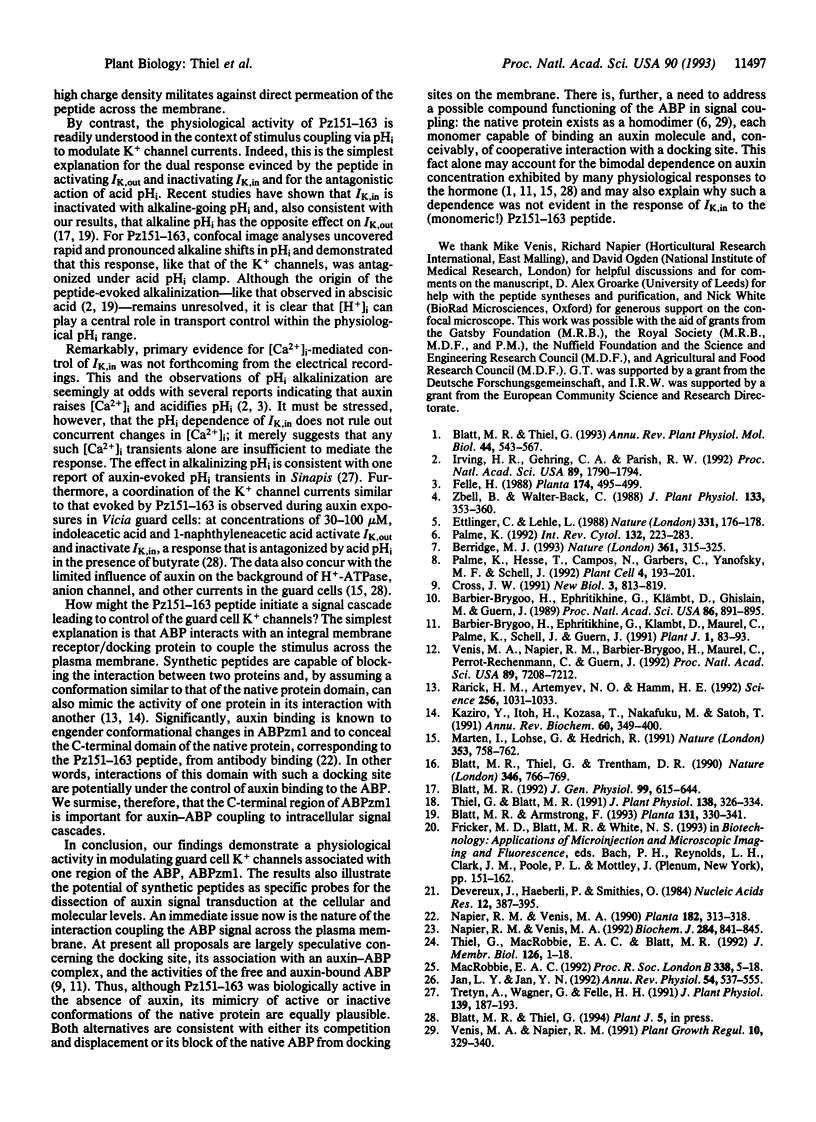
Images in this article
Selected References
These references are in PubMed. This may not be the complete list of references from this article.
- Barbier-Brygoo H., Ephritikhine G., Klämbt D., Ghislain M., Guern J. Functional evidence for an auxin receptor at the plasmalemma of tobacco mesophyll protoplasts. Proc Natl Acad Sci U S A. 1989 Feb;86(3):891–895. doi: 10.1073/pnas.86.3.891. [DOI] [PMC free article] [PubMed] [Google Scholar]
- Berridge M. J. Inositol trisphosphate and calcium signalling. Nature. 1993 Jan 28;361(6410):315–325. doi: 10.1038/361315a0. [DOI] [PubMed] [Google Scholar]
- Blatt M. R. K+ channels of stomatal guard cells. Characteristics of the inward rectifier and its control by pH. J Gen Physiol. 1992 Apr;99(4):615–644. doi: 10.1085/jgp.99.4.615. [DOI] [PMC free article] [PubMed] [Google Scholar]
- Blatt M. R., Thiel G., Trentham D. R. Reversible inactivation of K+ channels of Vicia stomatal guard cells following the photolysis of caged inositol 1,4,5-trisphosphate. Nature. 1990 Aug 23;346(6286):766–769. doi: 10.1038/346766a0. [DOI] [PubMed] [Google Scholar]
- Cross J. W. Cycling of auxin-binding protein through the plant cell: pathways in auxin signal transduction. New Biol. 1991 Aug;3(8):813–819. [PubMed] [Google Scholar]
- Devereux J., Haeberli P., Smithies O. A comprehensive set of sequence analysis programs for the VAX. Nucleic Acids Res. 1984 Jan 11;12(1 Pt 1):387–395. doi: 10.1093/nar/12.1part1.387. [DOI] [PMC free article] [PubMed] [Google Scholar]
- Ettlinger C., Lehle L. Auxin induces rapid changes in phosphatidylinositol metabolites. Nature. 1988 Jan 14;331(6152):176–178. doi: 10.1038/331176a0. [DOI] [PubMed] [Google Scholar]
- Irving H. R., Gehring C. A., Parish R. W. Changes in cytosolic pH and calcium of guard cells precede stomatal movements. Proc Natl Acad Sci U S A. 1992 Mar 1;89(5):1790–1794. doi: 10.1073/pnas.89.5.1790. [DOI] [PMC free article] [PubMed] [Google Scholar]
- Jan L. Y., Jan Y. N. Structural elements involved in specific K+ channel functions. Annu Rev Physiol. 1992;54:537–555. doi: 10.1146/annurev.ph.54.030192.002541. [DOI] [PubMed] [Google Scholar]
- Kaziro Y., Itoh H., Kozasa T., Nakafuku M., Satoh T. Structure and function of signal-transducing GTP-binding proteins. Annu Rev Biochem. 1991;60:349–400. doi: 10.1146/annurev.bi.60.070191.002025. [DOI] [PubMed] [Google Scholar]
- Napier R. M., Venis M. A. Epitope mapping reveals conserved regions of an auxin-binding protein. Biochem J. 1992 Jun 15;284(Pt 3):841–845. doi: 10.1042/bj2840841. [DOI] [PMC free article] [PubMed] [Google Scholar]
- Palme K., Hesse T., Campos N., Garbers C., Yanofsky M. F., Schell J. Molecular analysis of an auxin binding protein gene located on chromosome 4 of Arabidopsis. Plant Cell. 1992 Feb;4(2):193–201. doi: 10.1105/tpc.4.2.193. [DOI] [PMC free article] [PubMed] [Google Scholar]
- Palme K. Molecular analysis of plant signaling elements: relevance of eukaryotic signal transduction models. Int Rev Cytol. 1992;132:223–283. doi: 10.1016/s0074-7696(08)62457-2. [DOI] [PubMed] [Google Scholar]
- Rarick H. M., Artemyev N. O., Hamm H. E. A site on rod G protein alpha subunit that mediates effector activation. Science. 1992 May 15;256(5059):1031–1033. doi: 10.1126/science.1317058. [DOI] [PubMed] [Google Scholar]
- Thiel G., MacRobbie E. A., Blatt M. R. Membrane transport in stomatal guard cells: the importance of voltage control. J Membr Biol. 1992 Feb;126(1):1–18. doi: 10.1007/BF00233456. [DOI] [PubMed] [Google Scholar]
- Venis M. A., Napier R. M., Barbier-Brygoo H., Maurel C., Perrot-Rechenmann C., Guern J. Antibodies to a peptide from the maize auxin-binding protein have auxin agonist activity. Proc Natl Acad Sci U S A. 1992 Aug 1;89(15):7208–7212. doi: 10.1073/pnas.89.15.7208. [DOI] [PMC free article] [PubMed] [Google Scholar]



